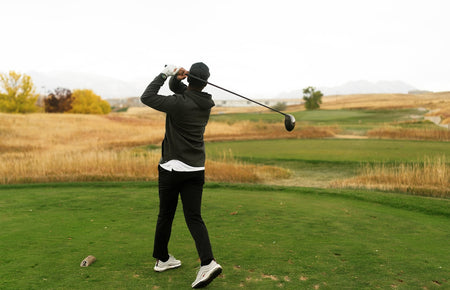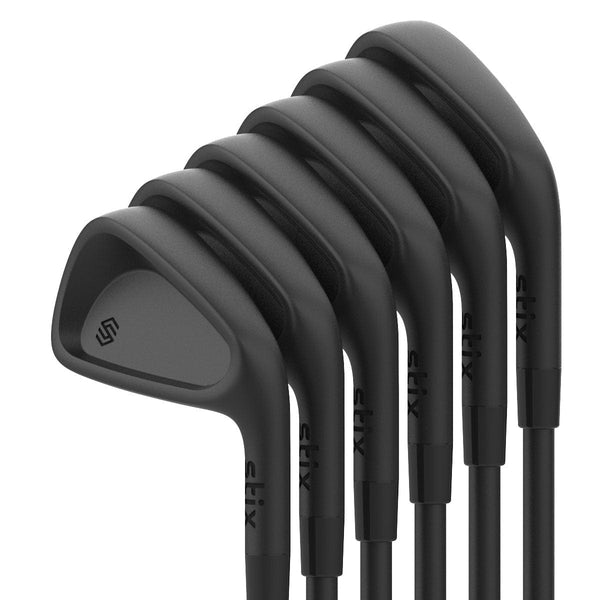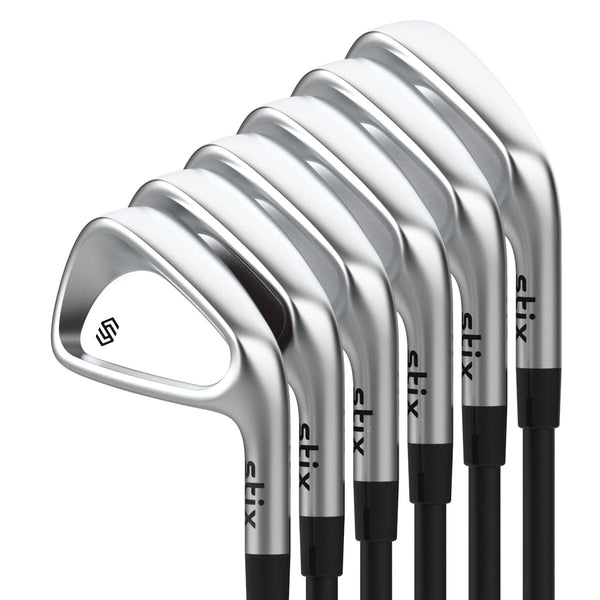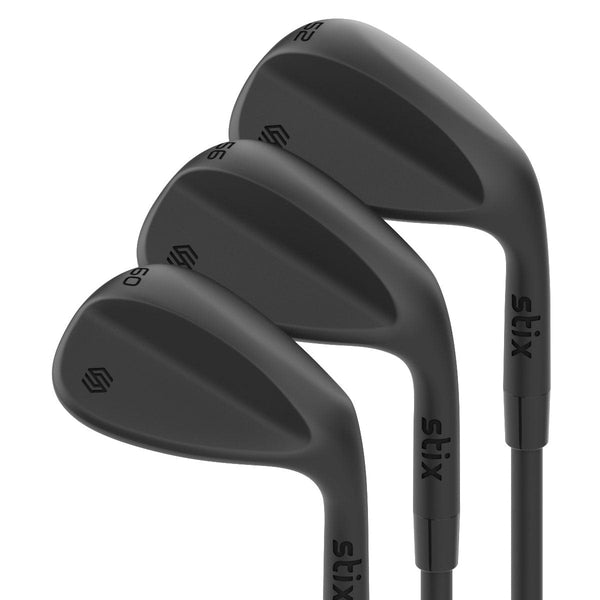As a golfer, it's helpful to understand the unique language of the game to fully enjoy and excel on the course. Don't worry if you're new to the sport or just need a refresher; our comprehensive glossary of golf terms has you covered.
We've carefully compiled over 100 golf terms, from equipment and course elements to scoring, shot types, and common golf slang. This easy-to-understand guide is perfect for players of all levels, making golf more accessible and fun for everyone. Ready to master the language of golf? Let's dive in!
Golf Terminology for Beginners
Equipment
No golf game is complete without the right equipment. We’ll kick this glossary of with a list of terms for essential items that every golfer should be familiar with:
- Club: The primary tool used to hit the golf ball. Clubs come in various types, including woods, irons, wedges, and putters, each designed for different purposes.
- Ball: A small, dimpled sphere that is the object of the game. Golf balls are designed to provide optimal distance, control, and spin. Learn more about hard and soft golf balls and their differences.
- Tee: A small peg, usually made of wood or plastic, used to elevate the ball for the first shot on each hole. Learn more: Golf Tee Size: Which Tee Length is Best for You?
- Golf bag: A bag designed to hold and organize a golfer's clubs and other accessories, such as balls, tees, and gloves.
- Putter: A club designed specifically for putting, with a flat-faced head used to roll the ball along the green.
- Irons: A set of clubs with a flat, angled face used for various shots, typically numbered from 3 to 9, with higher numbers indicating a higher loft and shorter distance. Learn more about golf irons.
- Woods: A set of clubs with a rounded head used for long-distance shots. The most common woods are the driver (1-wood) and fairway woods (3-wood, 5-wood).
- Hybrids: Clubs that combine the characteristics of both woods and irons, offering a more forgiving and versatile alternative for long shots.
- Wedges: A subset of irons with higher lofts, designed for short-range shots and specialty situations, such as escaping from bunkers or rough. Learn more: What Wedges Should a Beginner Carry.
- Driver: The longest club in the bag, with the largest head, used primarily for long-distance tee shots. Learn more: What is a 460cc Driver?
- Fairway wood: A wood club designed for use on the fairway, typically offering more control and accuracy than a driver.
- Pitching wedge: A wedge used for short, high-trajectory shots, typically from 100 to 125 yards.
- Sand wedge: A wedge with a wide sole and high loft, designed specifically for playing out of bunkers.
- Gap wedge: A wedge with a loft between a pitching wedge and sand wedge, used for shots between 75 and 100 yards.
- Lob wedge: A high-lofted wedge used for short, high shots with minimal roll, typically from 40 to 75 yards. Learn more about Golf Wedge Degrees.
- Putter types (blade, mallet): Blade putters have a narrow, flat head, while mallet putters have a larger, rounded head, providing more forgiveness on off-center hits.
- Golf glove: Worn on the lead hand (left hand for right-handed golfers) to improve grip and prevent blisters.
- Golf shoes: Shoes with spikes or molded grips on the sole for improved traction on the course.
- Divot repair tool: A small tool used to repair ball marks on the green, ensuring a smooth surface for putting.
- Ball marker: A small, flat object used to mark the position of a golfer's ball on the green while other players putt or when the ball is lifted for cleaning.
- Golf umbrella: A large umbrella designed to protect golfers and their equipment from rain or sun on the course.
Learn more: What is the Average Distance for Each Club?
Golf Course Elements
Every golf course has its unique layout, but they all share some common elements. Here's what you need to know about the different parts of a golf course:
- Hole: The objective of the game, consisting of a circular hole in the ground on the green, into which players aim to get the ball in as few strokes as possible.
- Tee box: The designated starting area for each hole, where players hit their first shot.
- Fairway: The well-maintained, short grass area between the tee box and green, where most play occurs.
- Rough: The taller grass areas surrounding the fairway and green, making shots more difficult due to reduced ball visibility and control.
- Green: The smooth, short grass area surrounding the hole, specifically designed for putting.
- Bunker: A sand-filled depression on the course, designed as a hazard to make play more challenging.
- Water hazard: Any body of water on the course, such as lakes or streams, that can affect play and penalize players for hitting their ball into it.
- Out of bounds: The area beyond the course's designated boundaries, usually marked by white stakes, where play is prohibited.
- Pin/flagstick: A tall pole with a flag, inserted into the hole to indicate its location on the green.
- Yardage markers: Colored markers or plates on the course that indicate distances to the green, usually measured in yards.
- Fringe: The slightly longer grass area surrounding the green, acting as a transition between the green and the fairway or rough.
- Apron: Another term for the fringe, referring to the area immediately around the green.
- Dogleg: A hole that features a significant bend in the fairway, requiring strategic shot placement to navigate successfully.
- Cart path: A designated path for golf carts to travel on, minimizing wear and tear on the course.
- Hazard: Any obstacle on the course, such as bunkers, water, or thick rough, designed to challenge players and add difficulty to shots.
- Ground under repair (GUR): An area of the course temporarily marked as out of play due to maintenance or damage, typically indicated by white lines or stakes.
Learn more: Golf Course Layout for Beginners & Beyond
Scoring and Handicaps
Understanding the scoring system in golf is crucial for tracking your progress and measuring your performance against others. Here are the key terms related to golf scoring and handicaps:
- Par: The standard number of strokes assigned to a hole or course, representing the expected score for a skilled golfer.
- Birdie: A score of one stroke less than par on a hole.
- Eagle: A score of two strokes less than par on a hole.
- Bogey: A score of one stroke more than par on a hole.
- Double bogey: A score of two strokes more than par on a hole.
- Handicap: A numerical representation of a golfer's playing ability, allowing players of different skill levels to compete fairly against each other. Learn more: Golf Handicap Explained
- Stableford scoring: A scoring system that awards points based on the number of strokes taken relative to par, encouraging aggressive play and minimizing the impact of poor holes.
- Match play: A format in which golfers compete hole by hole, with the winner of each hole earning a point.
- Stroke play: A format in which the total number of strokes taken over the entire round determines the winner, with the lowest cumulative score being the best.
- Gross score: The total number of strokes taken by a golfer during a round without accounting for their handicap.
- Net score: The golfer's gross score adjusted for their handicap, representing their actual performance relative to their skill level.
- Hole-in-one: The rare achievement of getting the ball into the hole with a single shot, typically on a par-3 hole.
Shot Types
A well-rounded golfer should be familiar with various types of shots to handle any situation on the course. Here are some essential shot types to know:
- Drive: A long-distance shot, usually played with a driver or fairway wood from the tee box.
- Approach: A shot intended to land the ball on the green, typically played with an iron or wedge.
- Chip: A short, low-trajectory shot used to get the ball onto the green from a close distance, usually played with a wedge or short iron. Learn more: Chip Shot vs. Pitch Shot
- Pitch: A high-lofted shot used to cover a short distance with minimal roll, often played with a wedge.
- Putt: A shot played on the green with a putter, aiming to roll the ball into the hole. Learn more: 10 Tips to Improve Your Putting Skills
- Flop: A high, soft shot used to clear obstacles and stop quickly on the green, usually played with a high-lofted wedge.
- Draw: A controlled shot that curves gently from right to left (for a right-handed golfer), often used to navigate around obstacles or follow the shape of a fairway. Learn more: Golf Draw vs. Fade.
- Fade: A controlled shot that curves gently from left to right (for a right-handed golfer), similar to a draw but in the opposite direction.
- Punch: A low-trajectory shot played to avoid strong winds or to keep the ball below overhanging tree branches.
- Bump and run: A low-trajectory shot that lands short of the green and rolls towards the hole, often used when the green is firm or the player has a tight lie.
Learn more: How to Hit a High and Low Golf Shot
Terms for Common Golf Rules and Etiquette
These basic rules are essential to understanding how the game is played and ensuring fair play on the golf course. Familiarize yourself with these golf terms to improve your golf etiquette and make your experience more enjoyable.
- Teeing ground: Golfers must start each hole from the designated teeing ground, placing their ball within the tee box's boundaries and no further than two club-lengths behind the markers.
- Order of play: The player with the lowest score on the previous hole tees off first on the next hole, known as having "honors." After teeing off, the player whose ball is farthest from the hole plays first.
- Lost ball: If a player cannot find their ball within three minutes of searching, they must declare the ball lost and take a one-stroke penalty. The player must then play a new ball from the original spot or, if applicable, the last point of entry into a hazard or out-of-bounds area.
- Unplayable lie: If a player deems their ball unplayable, they have three options: take a one-stroke penalty and drop the ball within two club-lengths of the original spot, no closer to the hole; take a one-stroke penalty and drop the ball on a line extending from the hole through the original spot, as far back as desired; or replay the previous shot with a one-stroke penalty.
Learn more: Golf Rules Made Simple: A Beginner's Guide to Golf Rules and Etiquette
Techniques and Strategies
Mastering various techniques and strategies is crucial for every golfer to enhance their skills and lower their scores. This section covers the terminology for some key concepts that will help you develop a well-rounded golf game.
- Aim: The process of aligning the clubface and body to target the intended shot direction.
- Alignment: The positioning of the golfer's feet, body, and clubface in relation to the target line. Learn more with or tips to improve alignment and aiming.
- Backswing: The motion of the club moving away from the ball, setting up the golfer for the downswing and impact.
- Downswing: The motion of the club moving from the top of the backswing towards the ball.
- Follow-through: The continuation of the swing after the ball has been struck, indicating a smooth and controlled motion.
- Grip: The way a golfer holds the club, affecting control, power, and shot shape.
- Stance: The golfer's body position, including foot placement and posture, while addressing the ball.
- Swing plane: The imaginary, tilted surface that the club travels on during the backswing and downswing, affecting the shot's accuracy and consistency.
- Weight transfer: The shifting of a golfer's body weight from the back foot to the front foot during the swing, promoting power and balance.
- Tempo: The rhythm and timing of a golfer's swing, affecting consistency and control.
- Shot shaping: The intentional manipulation of a golf shot's trajectory and curve, such as a draw or fade, to navigate obstacles or adapt to course conditions.
- Course management: The strategic approach to playing a round of golf, focusing on shot selection, risk assessment, and decision-making to maximize scoring opportunities.
Common Golf Slang and Phrases
Understanding the language of golf includes knowing some slang and phrases that golfers commonly use during a round. These expressions add color and fun to the game and can make your golf conversations more engaging.
Expressions for Good Shots
- Hole-in-one: When a golfer makes their tee shot and the ball lands directly in the hole.
- Pin high: A shot that lands on the green, even with the hole.
- Up and down: When a golfer successfully gets their ball onto the green and into the hole in just two strokes.
- Stiffed: A shot that lands very close to the hole, usually an approach or a chip.
- Dead: A shot that ends up in a perfect position, making the next shot much easier.
- Pure: A perfectly struck shot with a clean, solid contact.
- Flush: Another term for a pure shot, referring to solid contact between the clubface and the ball.
- Check up: When a ball lands on the green and stops quickly with minimal roll, usually due to backspin.
Expressions for Bad Shots
- Shank: A severe mishit where the ball contacts the club's hosel, causing it to veer sharply to the right (for a right-handed golfer).
- Chunk: A poorly executed shot where the clubhead hits the ground before the ball, resulting in a loss of distance and control.
- Whiff: A complete miss when attempting to hit the ball.
- Hook: A shot that curves significantly from right to left (for a right-handed golfer), typically caused by a closed clubface at impact.
- Slice: A shot that curves significantly from left to right (for a right-handed golfer), typically caused by an open clubface at impact. Follow these five steps to stop slicing and improve ball flight.
- Duffed: A mishit shot, often caused by hitting the ground before the ball or making poor contact.
- Skull: A mishit shot where the club's leading edge strikes the ball's equator, causing it to fly low and fast.
- Fat: Another term for a chunk shot, where the clubhead hits the ground before the ball.
- Thin: A mishit shot where the clubface strikes the ball too high, often causing it to travel too low and fast.
- Pull: A shot that starts left of the target line and continues on that path, often caused by an incorrect swing path.
- Push: A shot that starts right of the target line and continues on that path, similar to a pull but in the opposite direction.
- Top: A mishit shot where the clubface strikes the top part of the ball, causing it to roll or bounce instead of lifting into the air.
- Worm burner: A shot that travels very low to the ground, as if "burning" the worms beneath the grass.
- Banana ball: A slang term for a severe slice, resembling the shape of a banana.
Miscellaneous Phrases
- Mulligan: An informal term for retaking a shot without penalty, typically allowed only in casual rounds among friends.
- Gimme: A short putt that is considered so easy that it's automatically conceded by the other players.
- Fore: A warning shouted by golfers to alert others of an incoming ball that may hit them or come close.
- Play it as it lies: A rule stating that golfers must play the ball from its current position without altering the lie.
- The yips: A term describing a golfer's sudden loss of fine motor skills, usually affecting putting or chipping.
- Sandbagger: A golfer who intentionally plays worse than their ability to maintain a higher handicap, gaining an unfair advantage in handicap competitions.
- Caddie: A person who assists a golfer during a round, carrying the golf bag, offering advice, and providing moral support.
- Casual water: A temporary accumulation of water on the golf course, such as puddles after rain, from which a golfer may take free relief.
- Short game: The aspect of golf that involves shots played near or on the green, such as chipping, pitching, and putting. Learn more: 14 Ways to Level Up Your Short Game
- Long game: The aspect of golf that involves longer shots, such as drives and fairway shots, aimed at covering greater distances.
- Grain: The direction in which the grass grows on a putting green, affecting the roll and speed of putts.
- Lie: The position of the golf ball at rest, including the angle and type of surface (e.g., fairway, rough, or sand).
- Local rule: A rule specific to a particular golf course or competition, supplementing or modifying the standard rules of golf.
- Preferred lies: A local rule that allows golfers to improve their ball's lie without penalty, usually implemented during adverse course conditions.
- Provisional ball: A second ball played when the original ball is believed to be lost or out of bounds, potentially saving time and penalty strokes.
- Honors: The privilege of teeing off first, typically awarded to the golfer with the lowest score on the previous hole.
- Ready golf: An informal way of playing where golfers take their shots when ready, rather than strictly adhering to the order based on honors or distance from the hole, to speed up the pace of play.
- Unplayable lie: A situation where the golfer deems their ball impossible or impractical to play, and opts to take a one-stroke penalty for relief.
- Winter rules: Local rules, often implemented during the off-season, that allow golfers to improve their lie or take other actions to protect the course and facilitate play in adverse conditions.
That’s a hole-in-one
Congratulations, you've made it through our comprehensive glossary of golf terms! Whether you're a casual golfer, a golf enthusiast watching PGA tournaments on TV, or a newcomer to the sport, understanding these terms will enhance your enjoyment and help you feel more confident on the course.
Now that you're equipped with the language of golf, it's time to put your newfound knowledge into practice. Grab your clubs, head to the course, and enjoy the wonderful game of golf!
Feel like your clubs need an upgrade? Check out modern, affordable golf clubs →
Other popular guides:







